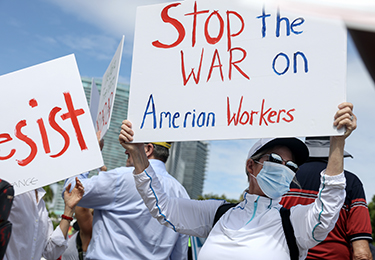The Trump administration's recent purge of federal workers will leave the U.S. unprepared to face public health threats such as infectious disease, foodborne illness, energy security and more, health experts warn.
Thousands of federal workers have been fired by the Trump administration through its so-called Department of Government Efficiency since Feb. 13, according to news reports. Exact numbers are difficult to pinpoint, as the department, headed by tech billionaire Elon Musk, has not publicly shared information on the firings. The cuts targeted newly hired workers who were in their probationary periods, as they have fewer job protections than permanent government personnel. As many as 200,000 workers were in their one- to two-year probationary periods as of last year, according to the U.S. Office of Personnel Management.
"These actions will not make America healthy," APHA Executive Director Georges Benjamin, MD, said. "Firing thousands of federal health workers who are dedicated to minimizing threats to the nation’s health will jeopardize the health of communities across the U.S."
About 5,200 workers are estimated to have been fired across U.S. Department of Health and Human Services agencies such as the National Institutes of Health, Food and Drug Administration and the Centers for Disease Control and Prevention, according to STAT News. CDC alone lost as many as 1,300 employees, affecting its ability to help state and local health departments track diseases and foodborne illnesses, as well as conduct regular data collection and carry out prevention initiatives such as the Vaccines for Children Program.
Nearly half of CDC’s Epidemic Intelligence Service — 135 workers — were fired despite their vital role in monitoring, tracking and tracing emerging disease outbreaks, said Rep. Rosa DeLauro, D-Conn., in a Feb. 16 news statement.
“EIS officers are at the front line of public health emergencies,” said DeLauro, a ranking member of the House Appropriations Committee and Labor, Health and Human Services, and Education Subcommittee. “They are on the ground when outbreaks occur so that we can contain diseases before they reach the U.S. We will not know the outcome of decimating this program until it’s too late — until Americans are dying from a disease we could have contained before it spread. This is nothing short of terrifying.”
Food and product safety is another major concern as cuts were expected to be made across FDA, affecting employees who regulate food products, medical devices and tobacco products, according to the Associated Press. While it’s unclear exactly how many staff were fired, at least some of them worked for FDA’s Center for Devices and Radiological Health, regulating imaging devices powered by artificial intelligence, according to STAT News.
NIH lost over 1,100 workers, according to Reuters, which could devastate the NIH Clinical Center’s progress on discovering lifesaving medicines and treatments for severe illness and diseases, including cancer. Staff cuts extend beyond research scientists and include data scientists, nurses, pharmacists and ethics specialists, according to Sen. Tammy Baldwin, D-Wis.
“I am all for making our government more efficient, but firing nurses and pharmacists who keep families healthy, disease experts who protect us from the next pandemic, and scientists finding cures for cancer is not what Americans signed up for,” Baldwin said in a Feb. 14 statement. “This will make Americans less healthy and safe — not more.”
 Nearly 500 EPA employees have been fired, as well as nearly 2,000 Department of Energy workers tasked with updating the nation’s power grid and overseeing clean energy and vehicle projects, according to Earthjustice. Cuts across the EPA and DOE also threaten clean air and water standards and rollback progress made toward clean energy sources that reduce U.S. on fossil fuels.
Nearly 500 EPA employees have been fired, as well as nearly 2,000 Department of Energy workers tasked with updating the nation’s power grid and overseeing clean energy and vehicle projects, according to Earthjustice. Cuts across the EPA and DOE also threaten clean air and water standards and rollback progress made toward clean energy sources that reduce U.S. on fossil fuels.
The DOE cuts also endanger U.S. energy security, including the loss of hundreds of workers for the Bonneville Power Administration which is the Pacific Northwest’s largest supplier of electricity and manages one of the nation’s largest power grids. The firings jeopardize the grid and are a “genuinely life-or-death concern for millions,” said Sen. Patty Murray, D-Wash.
“The callousness of this administration is breathtaking — these mass layoffs pose a serious threat to our energy security and the health and safety of people across our state, not to mention the livelihoods of so many hardworking families who have done nothing wrong and whose work is sorely needed,” Murray said in a Feb. 14 news statement.
Fourteen states have sued the federal government to block DOGE from carrying out mass layoffs and accessing sensitive information of federal employees. On Jan. 20, APHA and partners filed a lawsuit challenging the constitutionality of the department and its lack of transparency. People across the U.S. took to the streets on President's Day to protest the firings and attacks by the Trump administration on government agencies.
The American Federation of Government Employees, a union representing 800,000 federal and Washington, D.C., government employees, intends to pursue any and every legal challenge to the mass firings, according to organization President Everett Kelley.
"Agencies have spent years recruiting and developing the next generation of public servants,” Kelley said in a Feb. 14 news statement. “By firing them en masse, this administration is throwing away the very talent that agencies need to function effectively in the years ahead.”
Top photo: People protest the firing of thousands of federal workers on Feb. 17 in Miami, Florida. (Photo by Joe Raedle/Getty Images) Bottom photo: A protestor holds a sign in support of federal workers in Seattle, Washington. (Photo by Meade Krosby)